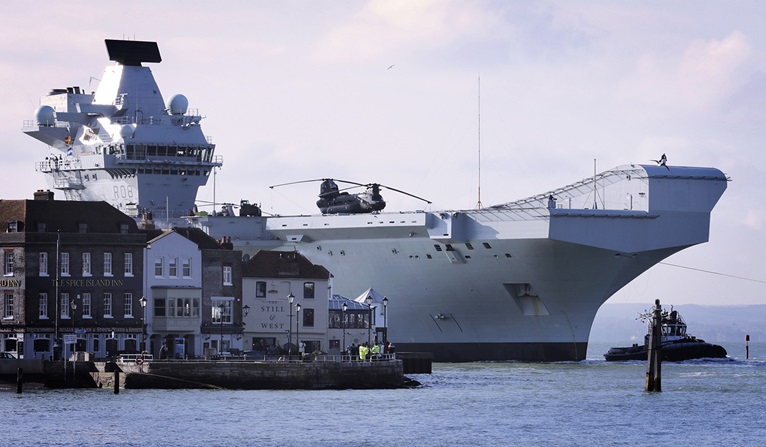Royal Navy Trials Amphibious Warfare Without Amphibs
Faced with the prospect of losing its last amphibs, the Royal Navy is revamping the concept of amphibious warfare without amphibious warfare vessels. In a first for the service in modern times, a troop of Royal Marines from 42 Commando embarked on the brand new aircraft carrier HMS Queen Elizabeth to test out a shoreside assault by helicopter, without the benefit of landing craft.
In recent decades, the Royal Navy’s amphibious assault capability has been provided by its former flagship, the helicopter carrier HMS Ocean, and the amphibs HMS Bulwark and HMS Albion. HMS Ocean was sold to Brazil last month, and Bulwark and Albion are rumored to be headed for early disposal due to budget and manning considerations. As a conventional jump-ramp aircraft carrier, Queen Elizabeth lacks an amphib's well deck for landing craft, but the Royal Navy believes that she can serve the same purpose using embarked helicopters. The recent exercise is intended as a step towards certifying the Queen Elizabeth for a "Landing Platform Helicopter" capability, and will be followed with more complex Royal Marines exercises this fall.
“HMS Queen Elizabeth will maintain the United Kingdom’s ability to have a forward-based strategic conventional deterrent which has the ability not only to conduct strike operations with the F-35B, which is its primary role, but also to have an embarked military force that is fully trained and ready to be projected ashore to conduct tasks that might arise," said Lt. Col. Mark Searight, the carrier's amphibious operations officer. He explained that the Royal Marines have been practicing helicopter assaults launched from shipboard platforms for decades, and that this is nothing new. (The service pioneered the use of helicopters in amphibious assault operations in the 1956 Suez Crisis.)
A group of Tory members of Parliament recently expressed their disapproval of government proposals to dispose of Britain's last amphibs and downsize the Royal Marines by 2,000 servicemembers (about one third of the total force). “After more than three and a half centuries of service to the nation, her majesty’s corps of Royal Marines is in danger of being sacrificed to short-term Treasury bookkeeping," the group said. “Disposing of our amphibious capability would not only put the interests of this country at serious risk, but would also be a drastic waste of tailor-made vessels, expensively refitted for another 15 years’ use, and of a military [specialty] that has been fostered across all three services."
Helicopter drills
The Royal Marines exercise paralleled extensive drills with two Merlin Mk2 and two Chinook helicopters, which together performed a thousand landings over the course of a month to get a baseline for the carrier's helicopter flight operating limits. The Royal Navy says that the aim is to map out ship motion, wind patterns on deck and turbulence to determine the widest operating envelope possible. With this knowledge in hand, the ship will be less constrained in its ability to maneuver during flight operations and pilots will be prepared for conditions on board.
"Whilst turbulence is normal, one of my pilots has described it as the 'Hand of God' grabbing you and pushing you down onto the ship, which obviously requires a big power demand to stop the aircraft descending, so that's given us some interesting insight," said test pilot and team leader Commander Matt Grindon. "We've been challenged, but that's exactly what these trials are for. "
The Queen Elizabeth's commanding officer, Capt. Jerry Kyd, said that the helicopter trials are an important step prior to the arrival of the carrier's complement of F-35B Lightning strike fighters. "The marriage at sea of the Lightning and our carrier in a few months time will [give] notice that the UK is on the cusp of returning to fixed wing carrier operations at sea and a return to serious maritime power projection," he said.

The Queen Elizabeth returns to port after her helicopter trials (Royal Navy)
